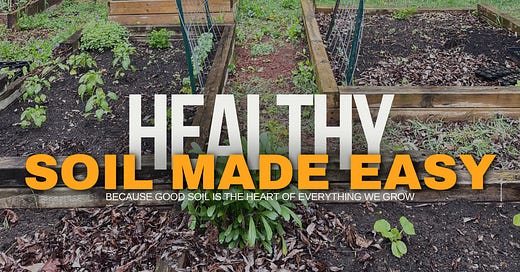Healthy Soil Made Easy: A Guide to Direct Composting
Because good soil is the heart of everything we grow
If you’ve been hanging out here a while, you know I’m always preaching the gospel of compost—but not just any composting. Direct composting. The kind where we skip the bin, skip the turning, and skip the waiting. We just feed the soil right where it matters most: in the garden bed itself.
Healthy soil isn’t something you buy in bags or build in a day. It’s alive. It’s constantly changing, adapting, and growing—just like our gardens. And direct composting is one of the simplest, most low-effort ways to keep that soil nourished, active, and thriving.
Why Direct Composting Works So Well
Think of it as slow-release nutrition. Instead of tossing your kitchen scraps into a separate pile and forgetting about them for months, you bury them directly into the beds. Banana peels, coffee grounds, apple cores, broccoli stems—all that goodness goes straight to the source. And as it breaks down, it feeds the microbes, worms, and fungi that turn plain dirt into living, breathing soil.
These underground helpers break down organic matter into nutrients your plants can actually use. It’s like having a quiet team of gardeners beneath the surface, working full-time to keep your garden healthy.
The Magic of Layering
One of my favorite things about direct composting is how naturally it fits into the rhythm of the seasons. I’ll dig little trenches or pockets between plants or in fallow corners, tuck the scraps in, and cover them with a bit of soil, leaves, or mulch.
Over time, those little layers build up. What started as a bit of lettuce or a handful of oatmeal becomes deep, rich soil. It’s slow magic—but it’s real magic.
And you don’t need to do it all at once. A scoop here, a handful there. One week it's carrot tops. The next week it’s the end of a loaf of bread (Can We Directly Compost Bread note) . Layer by layer, the soil improves.
What to Expect
You might notice a few things as your soil gets healthier with direct composting:
More earthworms: They LOVE kitchen scraps and leave behind castings that are pure gold.
Better drainage and moisture retention: Compost builds structure in the soil, helping it hold just the right amount of water.
Fewer fertilizers needed: When your soil is rich and alive, it does most of the feeding for you.
Plants that just look happier: Seriously. You’ll know.
A Few Tips for the Best Results
Chop things small if you want them to break down faster. Or don’t—nature’s not picky.
Balance with brown if you’re doing a lot at once. Dry leaves, shredded paper, or old mulch help keep things in harmony.
Rotate your compost spots to spread the goodness evenly around the garden.
Cover your scraps to keep smells down and critters out—mulch, soil, or even a flipped-over pot works great.
Let the Soil Do the Work
That’s the beauty of it: you’re not really doing much. You’re just giving your soil something to chew on, and it takes care of the rest. No flipping piles. No hauling bags. No overthinking.
Just feeding the soil and trusting the process.
In the end, direct composting isn’t just a way to manage food scraps—it’s a love letter to your soil.
And in return, the soil will give back in abundance: stronger plants, richer harvests, and a garden that practically grows itself.
Let me know in the comments—have you tried direct composting yet? Or are you thinking about giving it a go this season?
Beccalynne.
Can We Directly Compost Bread Note - I started a note series called ‘Can We Compost It’ so far. I’ve directly linked the one specific to bread for easy read after this one!



